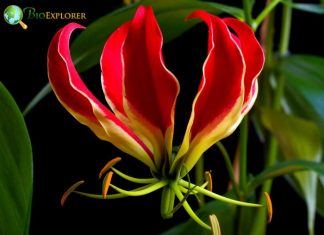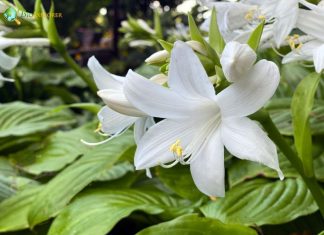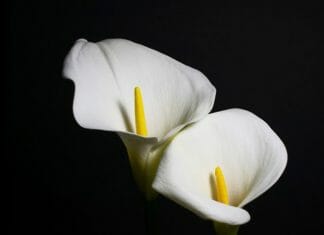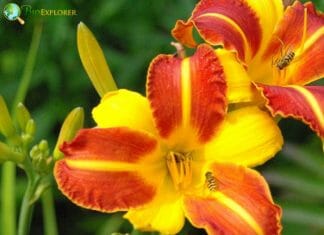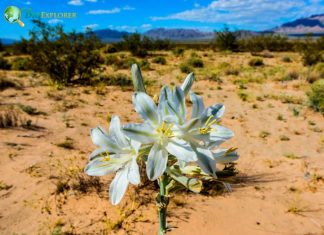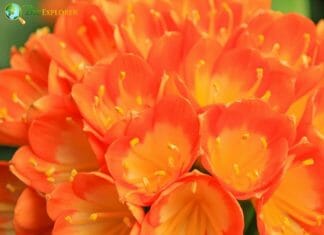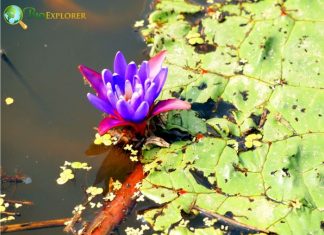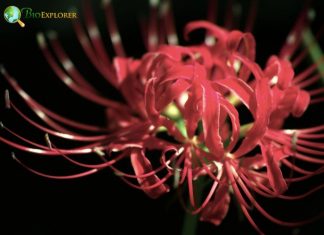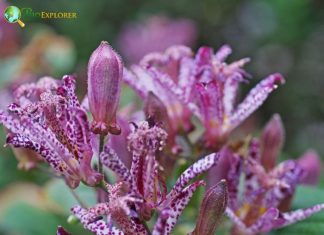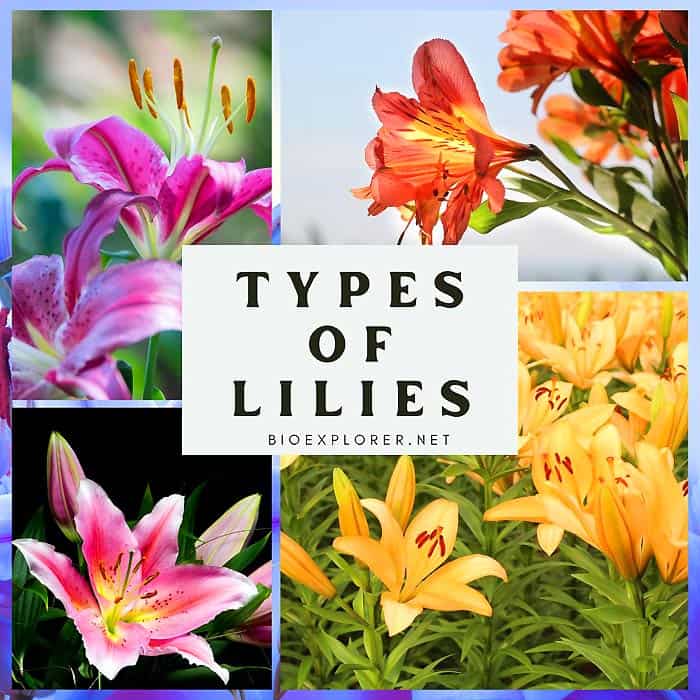 Lilies are a favored and adaptable flowering plant in many colors, shapes, and sizes. With many lily flowers available, selecting the perfect variety for your garden or landscape can seem daunting. From the eye-catching Oriental hybrids to the refined Asiatic varieties, lilies are vast and diverse.
Lilies are a favored and adaptable flowering plant in many colors, shapes, and sizes. With many lily flowers available, selecting the perfect variety for your garden or landscape can seem daunting. From the eye-catching Oriental hybrids to the refined Asiatic varieties, lilies are vast and diverse.
There are numerous lily types, each with distinct features and allure. Some popular lily species include the trumpet-shaped Easter lily, the fragrant Stargazer lily, and the vivid tiger lily. Additionally, many lesser-known lily breeds, such as the delightful Turk’s cap and the graceful martagon lily, are equally striking.
![]()
3 Major Classification of Lilies
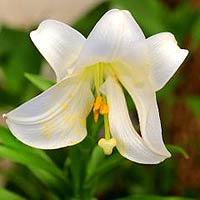
True Lilies
True lilies are plants belonging to the genus Lilium in the family Liliaceae. They are herbaceous flowering plants, typically growing from bulbs. They are characterized by large, often fragrant flowers, which come in diverse colors including whites, yellows, oranges, pinks, reds, and purples.
The flowers are usually borne on a single erect stem, with a scattering of leaves along its length. True lilies are distinguished by their six petal-like segments (tepals), six stamens, and a superior ovary, among other features. The bulbs of true lilies often have a scaly appearance without a protective outer layer.
Examples of true lilies include the Easter lily (Lilium longiflorum), Asiatic lilies (Lilium asiatica), and Oriental lilies (Lilium orientalis).
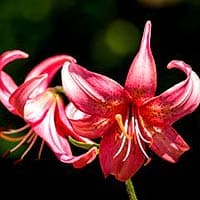
Hybrid Lilies
Hybrid lilies refer to the plants produced by cross-breeding different species or varieties of true lilies (genus Lilium). This cross-breeding is typically done to combine desirable traits from multiple parent lilies into a single plant. The resulting hybrids can exhibit a wide variety of colors, patterns, shapes, sizes, and fragrances depending on their parentage.
Some well-known hybrid lily groups include the Asiatic Hybrids, known for their bright colors and hardiness; the Oriental Hybrids, celebrated for their large, fragrant, and exotic-looking blooms; and the Trumpet or Aurelian Hybrids, recognized for their large, trumpet-shaped flowers. Other hybrid groups include Martagon Hybrids, Longiflorum Hybrids, and Interdivisional Hybrids.
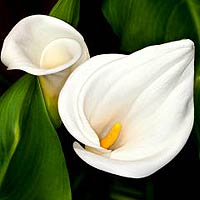
Non-True Lilies
Non-true lilies are plants that, despite bearing the name “lily” in their common names, do not belong to the Lilium genus, which constitutes the “true lilies.” They are diverse and can belong to various families and genera, which often share certain characteristics with true lilies, such as similar flower structures or growth habits, that have led to their colloquial naming.
Examples of non-true lilies include daylilies (Hemerocallis species), calla lilies (Zantedeschia aethiopica), and peace lilies (Spathiphyllum species). It’s crucial to recognize that although these flowering plants might display aesthetic similarities to true lilies, they can considerably differ in their biological traits, growth necessities, and care requirements.
Therefore, gardeners, plant enthusiasts, and the general public must be aware of these differences, especially regarding plant care and potential toxicity, as some non-true lilies can be harmful if ingested by pets or humans.
![]()
11 Classification of Hybrid Lilies
The hybrid lilies are classified into 11 different groups as shown below:

Asiatic Lily Hybrids
Asiatic Lily Hybrids, a group of vibrant and hardy flowers, are among the earliest blooming lilies in the spring and summer. They’re a favorite among gardeners due to their wide range of colors and relatively easy care requirements.
These lilies typically feature straight, tall stems topped with bold, outward-facing blossoms, often speckled or freckled. Colors range from the most delicate pastels to fiery reds and oranges, dazzling yellows, deep pinks, and even shades close to black.
The Asiatic Lily Hybrids are generally unscented, making them a great choice for those sensitive to strong fragrances. Some popular examples include the stunning golden ‘Grand Cru‘, the vibrant red ‘Landini‘, and the beautiful pink and white ‘Navona‘.
Asiatic Lilies are also known for longevity and are a striking addition to any garden or bouquet.
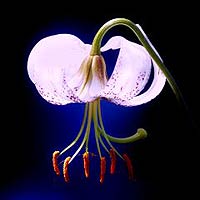
Martagon Lily Hybrids
Martagon Lily Hybrids, also known as Turk’s Cap Lilies, are treasured for their unique, downward-facing flowers with gracefully recurved petals, resembling a Turkish turban, hence the common name. These lilies bloom in early to mid-summer, filling the garden with a profusion of colors, including white, pink, lavender, orange, and deep red, often speckled.
A distinguishing feature is their whorled leaves along the stem, adding to their ornamental appeal. Martagon Hybrids are hardy and shade-tolerant, ideal for woodland gardens or dappled sunlight areas. They may be slow to establish but once settled, they are long-lived and require little care.
Popular examples include the bright orange ‘Arabian Knight‘, the pink ‘Pink Morning‘, and the White ‘Album‘.
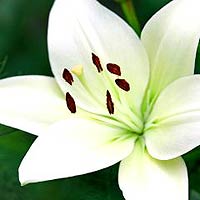
Candidum Hybrids
Candidum Hybrids, also known as Madonna Lilies, are renowned for their pure white, trumpet-shaped flowers that emit a delightful fragrance. Blooming in early to mid-summer, they have a long history of cultivation and are among the oldest types of lilies to be grown in gardens. They prefer alkaline soil and thrive best in sunny locations.
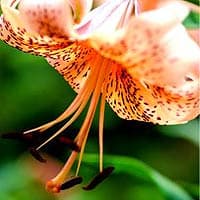
American Hybrids
American Hybrids are a diverse group of lilies native to North America. They are derived from several species, resulting in various colors and flower forms, from the Western Red Lily’s vibrant orange-red to the Michigan Lily’s subtle tones. These hardy lilies are known for their adaptability and resilience to different growing conditions, making them a great choice for naturalizing in woodland or meadow gardens.
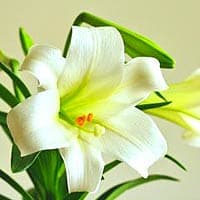
Longiflorum Hybrids
Longiflorum Hybrids, commonly known as Easter Lilies, are famous for their large, trumpet-shaped, white flowers and enchanting fragrance. They are traditionally associated with Easter celebrations due to their bloom time in the spring. These lilies prefer well-drained, slightly acidic soil and are often grown in pots for indoor enjoyment, but they can also be successfully cultivated outdoors in the garden.
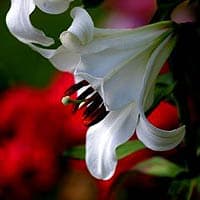
Trumpet or Aurelian Hybrids
Trumpet or Aurelian Hybrids are a majestic group of lilies known for their large, trumpet-shaped flowers, hence the name. These lilies are distinguished by their impressive height, often reaching up to 6 feet, and their strong, sweet fragrance that can fill an entire garden.
These hybrids typically bloom in mid to late summer, providing a spectacular display when many other flowers have finished their show. The color range of Trumpet or Aurelian Hybrids includes white, pink, yellow, and gold, and many have a contrasting color on the outside of the trumpet.
Popular examples include the golden ‘African Queen‘, the white ‘Casa Blanca‘, and the pink ‘Pink Perfection‘.
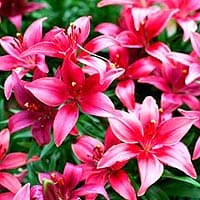
Oriental Hybrids
Oriental Hybrids are a spectacular group of lilies known for their large, exotic flowers and powerful, sweet fragrance. Blooming in late summer to early fall, these lilies provide an impressive display of color when many other flowers start to fade.
Their blooms can reach up to 8 inches in diameter and are often heavily freckled. The color palette of Oriental Hybrids includes rich shades of white, pink, red, and even deep burgundy.
Some popular examples include the famous white ‘Casa Blanca’, the pink ‘Stargazer‘, and the deep red ‘Black Beauty‘. Oriental Hybrids prefer a location with morning sun and afternoon shade, requiring well-drained, slightly acidic soil.
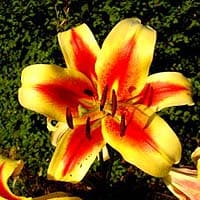
Orienpet Hybrids
Orienpet Hybrids, often called OT Hybrids, are a remarkable group of lilies resulting from crossbreeding Oriental and Trumpet (Aurelian) lilies. They combine the best traits of both parents: the large, fragrant flowers and vibrant colors of Oriental lilies and the hardiness, heat tolerance, and tall, robust stems of Trumpet lilies.
In mid to late summer, OT Hybrids offer a striking array of colors, including white, pink, yellow, and deep red, often with contrasting bands or speckles.
Some popular examples include the luminous ‘Silk Road‘, the radiant ‘Black Beauty‘, and the vibrant ‘Scheherazade‘.
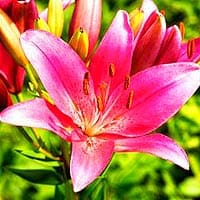
LA Hybrids
LA Hybrids are a striking group of lilies that result from the cross between Longiflorum (Easter lilies) and Asiatic lilies. This cross combines the large, trumpet-shaped flowers and sweet fragrance of the Longiflorum lilies with the hardiness, diverse colors, and early bloom time of the Asiatic lilies.
The blooms of LA Hybrids can be up-facing, out-facing, or pendant, and they exhibit a broad palette of colors, including white, pink, red, orange, yellow, and even two-toned or speckled varieties.
Popular examples include the vibrant ‘Royal Sunset‘, the pristine ‘Eyeliner‘, and the two-toned ‘Lollipop‘.
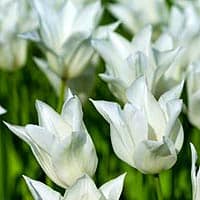
LO Hybrids
LO Hybrids are an exciting group of lilies that emerge from the cross between Longiflorum (Easter lilies) and Oriental lilies.
These hybrid lilies combine the impressive, trumpet-shaped flowers and sweet fragrance of the Longiflorum lilies with the large blooms, exotic colors, and the heavy scent of the Oriental lilies. LO Hybrids typically bloom in mid to late summer and display a wide range of colors, including white, pink, red, and various shades.
The flowers can be up-facing, out-facing, or pendant, and they often bear the characteristic speckles of their Oriental parent.
Some popular examples include the elegant ‘Triumphator‘, the blushing ‘Pink Heaven‘, and the radiant ‘Star Gazer‘.
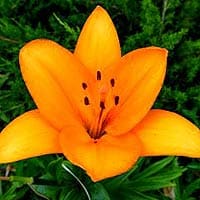
Interdivisional Hybrids
Interdivisional Hybrids are an intriguing group of lilies that result from crossbreeding from different hybrid divisions. They are bred to combine the best traits from each parent, which can lead to various characteristics.
The flower shape, color, size, fragrance, and bloom time can all differ significantly depending on the specific parentage. As a result, Interdivisional Hybrids offer an incredibly diverse range of options for the gardener, from the large, fragrant, and brightly colored blooms of the OT (Orienpet) Hybrids to the robust and diverse LA (Longiflorum x Asiatic) Hybrids.
Notable examples include the OT Hybrid ‘Garden Pleasure‘, known for its large, fragrant, pink and white flowers, and the LA Hybrid ‘Royal Trinity‘, loved for its rich, orange blooms.
![]()
Types of True Lilies
Most of the true lily species (Lilium) are perennial plants except a few lilies such as Easter lilies might survive through winter depending upon the locations. However, the remaining true-lily species live for over two years, typically flowering and producing seeds repeatedly throughout their lives. Each flower will bloom and die within a single growing season, but the plant can continue to live, grow, and bloom for many years.
According to Lilium Species Foundation (LSF), true lilies (120 species) are further classified into 7 sections based on their endemic locations. The following section describes all 120 lily species.
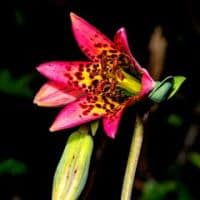
Bolander's Lily
Bolander’s Lily, or Lilium bolanderi, is native to the western coastal regions of the United States. This lily is adorned with vibrant, burgundy-red, or deep pink flowers. This species does not exude a strong fragrance unlike some of its counterparts.
It was first described by botanist Sereno Watson in 1879, named after the German-American botanist Henry Nicholas Bolander. A distinguishing feature is its flower’s downturned petals, revealing an attractive cluster of stamens at its center.
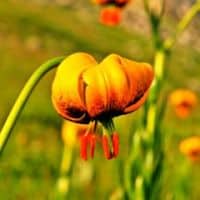
Bosnian Lily
The Bosnian Lily (Lilium bosniacum) hails from the mountainous regions of Bosnia and Herzegovina. These lilies present a unique bell-shaped flower adorned with a deep purple or magenta color.
Though they require well-drained soil and partial shade, their natural beauty is worth the effort. A peculiar feature about these lilies is their ability to withstand lower temperatures better than most other lily species, making them a fascinating fit for colder climates.
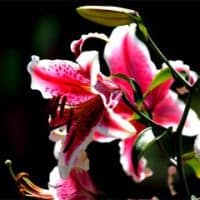
Brown's Lily
Lilium brownii is a lily species native to Mainland China, Hong Kong, Kinmen and Matsu Islands, northern and central Vietnam, and Kachin of Myanmar. It is also known as Hong Kong lily and Brown’s lily.
The plant is named ‘brownii‘, which suggests it was named to honor an individual with the surname ‘Brown’. However, it’s unclear whether this refers to Robert Brown, the well-known British botanist, or another person named Brown. There are two accepted varieties of L. brownii: L. brownii var. brownii and L. brownii var. viridulum.
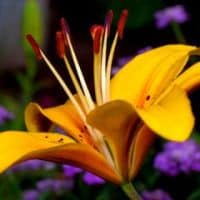
Canada Lily
Lilium canadense, known commonly as the Canada Lily, Wild Yellow-Lily, or Meadow Lily, is native to eastern North America. It showcases large, bell-shaped flowers colored in an enchanting yellow to red. Its stamens, long and protruding, offer a unique visual appeal.
This lily was first described by the renowned Swedish botanist Carl Linnaeus in the mid-18th century. Interestingly, the Canada Lily is a food source for the caterpillar of the rare Mustard White butterfly.
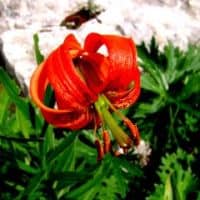
Carniolan Lily
The Carniolan Lily (Lilium carniolicum) is a native of southeastern Europe. The name ‘carniolicum’ is derived from Carniola, a historical region comprising parts of present-day Slovenia where the species was first described.
Its flowers are unique, with deeply recurved petals colored in a rich golden yellow and adorned with a speckling of maroon spots. It prefers rocky, well-drained soils and can tolerate shade more than other lilies. It’s worth noting that this lily has remarkable resilience to pests, making it a more durable choice.
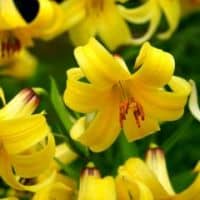
Caucasus Lily
The Caucasus Lily (Lilium monadelphum) is a bulbous geophyte native to the Caucasus region, Turkey, and Krym. It has down-facing butter yellow flowers with purple spots shaped like Turk’s caps on stems that stand 4 feet tall. The petals are refluxed, and the anthers are fused into a tube at the base.
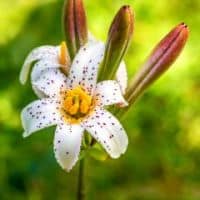
Chaparral Lily
The Chaparral Lily (Lilium rubescens) hails from the western United States. Its flowers are a soft pink to white color and are highly fragrant, especially in the evening. This lily was first described by Asa Gray, an influential American botanist. A unique trait of the Chaparral Lily is its ability to thrive in the dry, rocky conditions of chaparral ecosystems, where most other lilies would struggle.
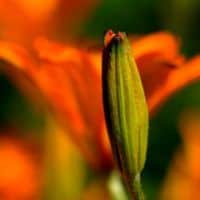
Coast Lily
The Coast Lily (Lilium maritimum) is a lily species native to the contiguous United States. The plant is endemic to California, known only from the coastline north of San Francisco. It formerly occurred south of San Francisco, but these occurrences have all been extirpated. The oval leaves are mostly basal, with a few alternates on the lower stem.
The plant grows from a scaly, elongated bulb several centimeters long. The flowers are vibrant, rich red with a deep orange throat. An unusual trait of this lily is its preference for foggy coastal habitats, making it a unique choice for seaside gardens.
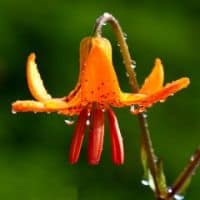
Columbia Lily
The Columbia Lily, also known as the Tiger Lily or Lilium columbianum, is native to western North America. It produces stunning, vibrant orange flowers with spots reminiscent of a tiger’s coat, thus its common name. It was first identified by Sereno Watson, a 19th-century American botanist. A fascinating aspect of this lily is that its bulbs have been a food source for indigenous people in its native regions for centuries.

David's Lily
David’s Lily (Lilium davidii) is a species of lily native to mountainous areas of China, including Assam, Manipur, Arunachal Pradesh, Tibet, Bhutan, Hubei, Shaanxi, Sichuan, Guizhou, and Yunnan. It is an erect bulbous perennial lily with an unbranched stem bearing scattered linear leaves.
From mid to late summer, it produces striking pendants to nodding flowers that are 2 inches long and range from red to reddish-orange. The flowers are loosely arranged in a showy raceme, resembling a Turk’s cap with sepals and recurved tepals (bent backward). Some variations of David’s Lily exhibit deep red flowers.
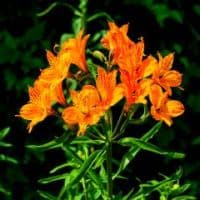
Dwarf Red Lily
The Dwarf Red Lily or Lilium pumilum hails from Mongolia and northeastern China. It’s known for its fiery, red-orange, Turk’s cap-style flowers. This lily was first described by Carl Peter Thunberg. Despite its name, the ‘Dwarf’ Red Lily can reach heights up to 18 inches, making it a standout in any rock garden or border.
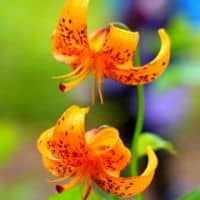
Dwarf White Lily
The Dwarf White Lily or Lilium debile is found in the Far East of Russia and northeast China. It’s known for its delicate, cream-colored, nodding flowers that contrast beautifully with its dark, glossy leaves.
This lily was first identified by Carl Maximowicz, a Russian botanist. Interestingly, despite its delicate appearance, this lily is tough and hardy, capable of withstanding harsh climates in its native habitat.
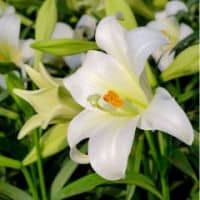
Easter Lily
The Easter Lily (Lilium longiflorum) hails from the Ryukyu Islands of Japan. It’s most recognized for its large, trumpet-shaped, pristine white flowers emblematic of Easter traditions in many cultures. This species was first described by Carl Peter Thunberg, a Swedish naturalist. A unique feature of the Easter Lily is its particularly long flowering period, with blossoms lasting up to a month in the right conditions.
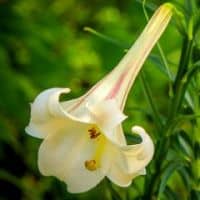
Formosa Lily
The Formosa Lily or Taiwanese Lily (Lilium formosanum) is native to Taiwan. It is closely related to the Easter lily found in the Ryukyu Islands of Japan, eastern and northern Taiwan. The plant displays large, trumpet-shaped flowers ranging from pure white to soft pink, with a delicate fragrance. It was first described by British botanist Henry Fletcher Hance in the 19th century.
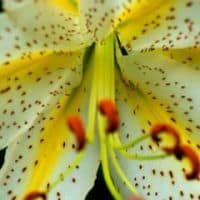
Golden-rayed Lily
The Golden-rayed Lily or Goldband Lily, scientifically known as Lilium auratum, is a native species from Japan. Its popularity stems from its large white flowers that can reach 10 to 12 inches in diameter and are adorned with gold stripes down each petal.
The flowers also have an intoxicating sweet fragrance, a summer highlight. It’s commonly found on forested mountainsides, fitting into well-drained soil and partial sun to light shade conditions. One interesting fact about the Goldband Lily is that it has one of the largest flowers among lily species and its essential oil is popular in perfumery.
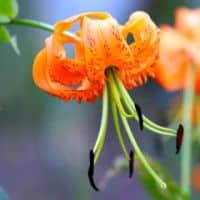
Henry's Lily
Lilium henryi, or Henry’s Lily, originates from China. This lily is adorned with beautiful, orange-yellow flowers that feature recurved petals with brownish-purple spots. It’s named after Irish plant collector Augustine Henry, who discovered this species in the late 19th century.
A fascinating characteristic of this lily is its ability to self-pollinate and produce viable seeds, making it an excellent candidate for garden propagation.
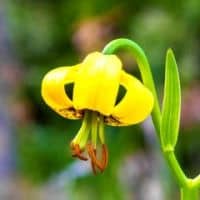
Janka's Lily
Janka’s Lily (Lilium jankae) is a protected species in Bulgaria. It is a bulbous geophyte that grows primarily in the temperate biome and is native to Bulgaria, Greece, Italy, Romania, and Yugoslavia. The stem of this perennial herbaceous plant is erect and can grow up to 60 cm high. The leaves are numerous, spirally arranged, and oblong-lanceolate.
The flowers are one or several at the top of the stem, up to 6 cm in diameter, golden yellow, usually to its base with purple dots and streaks. Flowering occurs from June to August.
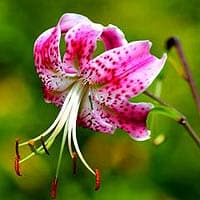
Japanese Lily
Lilium speciosum, also known as the Japanese Lily, is a flowering plant native to southern Japan and southern China. It can grow up to 4 feet tall and 1 foot wide, blooms from August to September in north temperate regions. The flowers are strongly scented and can be white, pink, or red-spotted.
The species has been widely used to breed garden forms. Lilium speciosum contains phenolic glycosides and steroidal saponins. The Lily pollen is toxic to domestic cats and ingestion is often fatal.
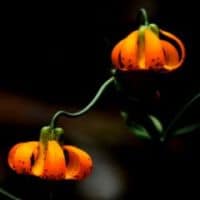
Kelley's Lily
Kelley’s Lily, or Lilium kelleyanum, is native to the western United States. Its flowers are characterized by their deep, lemon-yellow color with maroon spots near the center. This lily was named after Albert Kelley, a California botanist who contributed significantly to the knowledge of the flora of his region.
Unusually, Kelley’s Lily is found in chaparral, a unique and fire-prone ecosystem characterized by dense, drought-tolerant shrubs.
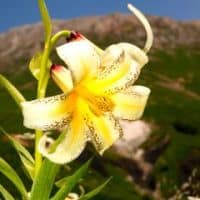
Kesselring's Lily
Kesselring’s Lily (Lilium kesselringianum) is a large herbaceous member of the Lilium genus that is native to the North and South Caucasus as well as northern Turkey. It grows from sea level along the Black Sea into the mountains to subalpine level on forest edges, in brushlands, and in grassy meadows.
The plant showcases large, impressive, bell-shaped flowers in a captivating shade of deep magenta. It’s named after Russian botanist Sergey Kesselring. One notable feature of this lily is its ability to thrive in wet environments, which sets it apart from many other lily species that require well-drained soils.
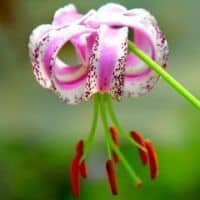
Lankongense Lily
The Lankongense Lily (Lilium lankongense) hails from China. It displays beautiful, reflexed flowers with a soft pink color and darker spots. E.H. Wilson, a notable British plant collector, first identified the species. One interesting feature of this lily is its seeds, which are significantly larger and flatter than most other lily species.

Lemon Lily
The Lemon Lily (Lilium parryi) is a rare lily species endemic to the southwestern United States and northwestern Mexico, where it grows in moist areas in mountain habitats. It is also known as Parry’s lily. The Lemon Lily has five petals in a trumpet form. This perennial can grow up to 2 meters from a scaly, elongated bulb up to 11 centimeters long.
The leaves are generally linear in shape, up to 29 centimeters long, and usually arranged in whorls around the stem. The Lemon Lily is the only true Lilium species native to California. It is known from the San Bernardino and San Gabriel Mountains and a few remaining spots near Palomar Mountain to the south. In Arizona, there is only one Lilium species, which is L. parryi. The Lemon Lily was named in honor of Charles Christopher Parry, a British-American botanist and mountaineer. The Lemon Lily Festival, which celebrates this species, is held in Idyllwild, California.
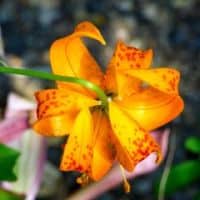
Leopard Lily
The Leopard Lily (Lilium pardalinum), also known as Panther Lily, is a flowering bulbous perennial plant native to Oregon, California, and Baja California. It is a woodland species that often grows near streams and in moist forest areas. The plant spreads by creeping, rhizomatous bulbs to form charming and graceful colonies.
The flowers are highly reflexed with stamens strongly exerted, and they are nodding, orange-red Turk’s cap flowers, 3 in. across (9 cm), shading to yellow near the center and covered with brown spots, giving the appearance of the leopard’s skin.
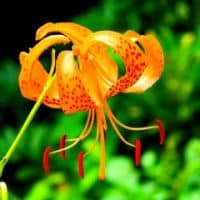
Light Yellow Lily
The Light Yellow Lily or Lilium leichtlinii is native to Japan. It features elegant, recurved petals in a subtle yellow hue, adorned with dark maroon spots. This lily is named after Max Leichtlin, a German botanist. Intriguingly, Light Yellow Lily has an unusual tendency to produce twin flower stems, a rarity in the plant kingdom.
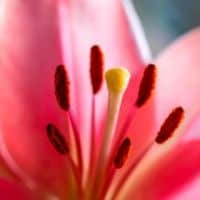
Madonna Lily
The Madonna Lily, or Lilium candidum, has a rich history dating back to ancient Crete and the Middle East and is often associated with religious and historical symbology. It’s renowned for its pure white trumpet-shaped flowers, which exude a captivating fragrance.
Unlike most of its counterparts, this lily species requires a dry dormancy period in late summer. According to ancient herbal texts, the Madonna Lily is one of the oldest cultivated flowers and is said to have medicinal properties.
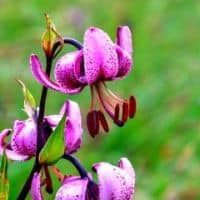
Martagon Lily
The Martagon Lily, also known as Turk’s Cap Lily (Lilium martagon), originates from Eurasia. Its unique, recurved petals in a variety of colors ranging from white to pink and purple, with a plethora of dark spots, give the flower a distinctive turban-like appearance.
This lily was first described by Carl Linnaeus in the mid-18th century. It’s interesting to note that ‘martagon’ is a Turkish word for a type of turban, reflecting the shape of the flower.

Morning Star Lily
Morning Star Lily, also known as Lilium concolor, is native to East Asia, specifically China. It is a trumpet lily growing from 4 to 8 feet tall on slender green to purple stems clad with lance-shaped deep green leaves (6” long).
The flowers are star-shaped and colored in a bright, vivid red-orange with maroon spots. Morning Star Lily is resistant to the lily mosaic virus, which is a common disease that affects many other lilies.
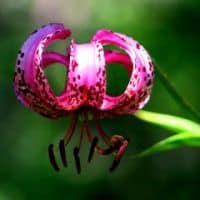
Nodding Lily
Lilium cernuum, known as Nodding Lily, hails from Eastern Asia. This species is named for its nodding flowers, which hang pendulous from the stalk. These unique flowers showcase a lovely soft pink hue with deep pink speckles.
The Nodding Lily was first described by Carl Maximowicz, a Russian botanist in the 19th century. A distinctive feature of this lily is its resilience to harsh climates, as it thrives in its native habitat of rocky mountain slopes and forest edges.
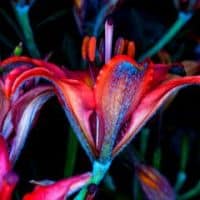
Orange Lily
The Orange Lily, also known as Lilium bulbiferum is native to Europe. It can reach up to 3 feet tall with long, lance-shaped leaves and showy, bright orange flowers that bloom in early to mid-summer.
The common name “Fire Lily” stems from the vibrant, fiery orange color of its flowers. This species is unique because it grows bulbils in its leaf axils, which can fall off and grow into new plants. Carl Linnaeus described this species in 1753.
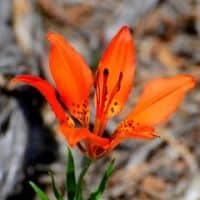
Philadelphia Lily
The Wood Lily, also known as Philadelphia Lily (Lilium philadelphicum), is native to North America. It boasts vibrant, orange-red flowers with a scattering of dark spots. This lily was first described by Carl Linnaeus.
Interestingly, this species is highly variable in its growth habits and can range from just a few inches to several feet in height, depending on its environment.
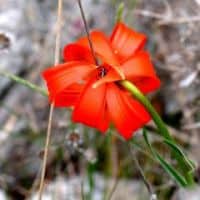
Pomponium Lily
The Pomponium Lily (Lilium pomponium) originates from the Alps and the Apennines in Europe. It displays elegant Turk’s cap-style flowers in a vibrant shade of scarlet red. This lily was first described by Carl Linnaeus. Its common name ‘pomponium‘ refers to its flower’s rounded, ‘pompom’-like shape.
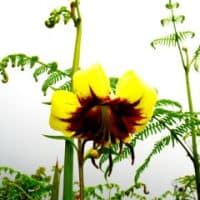
Primrose Lily
The Primrose Lily (Lilium primulinum) is a species of lily that features small yellow flowers, shaded green with a purple patch in the throat. The species was first identified by British botanist George Forrest and is native to central China.
This lily is also known as L. ochraceum and its bulbs are usually stoloniferous, meaning they spread through the production of long, horizontal underground stems or stolons.
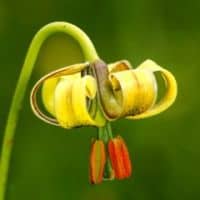
Pyrenean Lily
The Pyrenean Lily (Lilium pyrenaicum) is a species of lily native to the Pyrenees mountains in Europe. It is a hardy, tall plant, growing up to 3 feet in height, with large, upward-facing flowers that are usually pink, red, orange, or yellow.
It bears up to 12 Turks-cap-shaped yellow, orange, or red flowers and has an unusual musky scent, which some people find unpleasant. The Pyrenean Lily was first described by Carl Linnaeus.
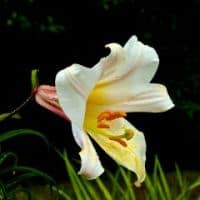
Regal Lily
The Regal Lily or Lilium regale is a trumpet-type lily native to the western part of Sichuan Province in southwestern China. This spectacular lily was introduced to England in 1903 by Ernest Henry Wilson, a notable British plant enthusiast. The plant typically grows 3-5′ tall (sometimes to 6′ when well established) on rigid stems.
The leaves are narrow and deep green, and the flowers are large, trumpet-shaped, and white with yellow in the center. The outside of the flowers is streaked with pink or lilac, and they emit a strong fragrance. The Regal Lily is probably the easiest white lily to grow and is perfect for growing in a mixed sunny border or container display.

Scarlet Lily
The Scarlet Lily or Chalcedonian Lily (Lilium chalcedonicum) is native to Greece, Albania, and Tuscany. It displays vibrant, scarlet-red flowers with strongly reflexed petals, giving it a unique ‘Turk’s cap’ shape.
Under its current name, Carl Linnaeus first classified this lily in 1753 on Mount Chalcedon in Thessaly. The bulbs of this lily are deeply buried in the ground, often up to a foot below the surface, which helps it withstand summer heat and winter cold.
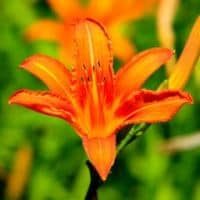
Siberian Lily
The Siberian Lily (Lilium distichum) is native to East Asia, particularly in Siberia, Korea, and northeastern China. It was first described by Carl Peter Thunberg, a Swedish naturalist, in the 18th century. The lily is known for its striking, bright orange flowers with dark spots, which grow in an umbel-like cluster at the top of the stem.
However, the leaves of the Siberian Lily are not arranged in two distinct vertical rows along the stem. This description matches another lily species called Lilium superbum, commonly called Turk’s cap lily, which is native to eastern North America.
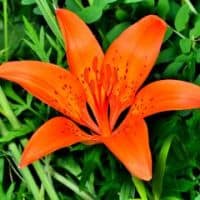
Siberian Turk's Cap Lily
The Siberian Turk’s Cap Lily (Lilium pensylvanicum) is native to northeastern Asia and eastern Europe. It presents vivid orange flowers with dark spots, reminiscent of a leopard’s coat. This lily was first described by Carl Linnaeus, the father of modern taxonomy.
Its name, ‘pensylvanicum,’ might suggest a connection with Pennsylvania in the United States, but this is a misnomer, as the species is not native to that area.
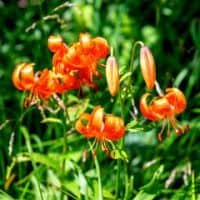
Spiked Lily
The Spiked Lily (Lilium medeoloides) is native to the Far East of Russia and Japan. It’s known for its bright orange, Turk’s cap-style flowers with raised, dark spots. This lily was first identified by Carl Johann Maximowicz, a notable Russian botanist.
Intriguingly, this species has a spike-like growth habit, with flowers and leaves growing from the stem in whorls, lending it its common name.
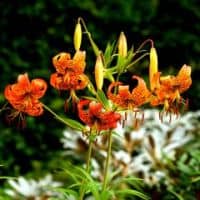
Superb Lily
Lilium superbum, also known as the Turk’s cap lily, is endemic to North America’s eastern and central regions. It is commonly called turban lily, swamp lily, lily royal, or American tiger lily. The native range of the species extends from New Hampshire south to the Florida Panhandle, west to Missouri and Arkansas, and all the way north. It is the largest and most spectacular Native American lily, typically growing 4-6 feet tall, but can grow up to 8 feet tall.
It has large, bright orange flowers, recurved petals, and darker speckles. The flowers have a green star at their center that can be used to distinguish Lilium superbum from Asiatic “tiger lilies” that frequently escape from cultivation. It blooms in early to mid-summer and can have up to 40 flowers on a single plant. Carl Linnaeus first described Lilium superbum in 1753.
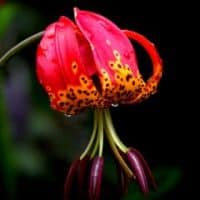
Tiger Lily
The Tiger Lily (Lilium lancifolium) is native to East Asia, and it can grow up to 6 feet tall. This lily flower prefers full sun to partial shade and well-draining soil. The plant blooms in mid to late summer and attracts butterflies and hummingbirds.
Its vibrant orange flowers with black spots make it instantly recognizable, and its downward-facing flowers with upward-curling petals give it a distinctive appearance. The bulbs of the Tiger Lily are edible and have been used in traditional Chinese medicine for their anti-inflammatory properties. Overall, the Tiger Lily is a beautiful and unique plant with cultural significance in East Asia.
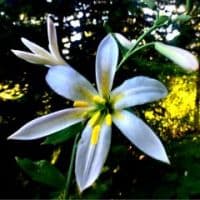
Washington Lily
The Washington Lily, also known as Lilium washingtonianum, is a North American plant species in the lily family. It is native to the Cascade Range and the Sierra Nevada of western North America, and its range is limited to California and Oregon. The plant grows up to 2 meters tall and bears large fragrant white or pinkish flowers often decorated with purplish spots.
The flowers start as pinkish or lavender and gradually turn white as they mature. The Washington Lily was named after Martha Washington, the first First Lady of the United States, and not the state of Washington.
This species is highly fragrant, particularly in the evening and at night. The habitat for Washington Lily ranges from chaparral to open conifer forest including early successional forest at elevations of 400 to 2,200 meters.
Suggested Reading: Speaking of Washington, check out top Birds of Washington | White Annual Flowers | Butterfly Colorful Wings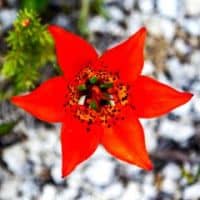
Western Lily
The Western Lily, also known as Lilium occidentale, is a rare North American lily native to northwestern California and southwestern Oregon. It grows in coastal prairie habitats, swamps, and stagnant bogs with Drosera species, bluffs and sandy cliffs, and seaside spruce forests. It is considered an endangered species and is listed under the federal Endangered Species Act.


